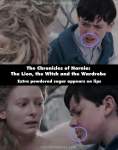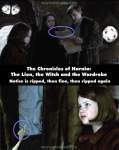Visible crew/equipment: When Mrs. MacReady meets the Pevensie children at the train station, the reflector screen is reflected in the lenses of her glasses, as she looks down when she speaks to them. It is also visible when the children first arrive at the house, when Mrs. MacReady says, "There shall be no disturbing of the professor." (00:07:30)


Continuity mistake: When Edmund speaks with the White Witch the first time, as he eats the Turkish Delight candy, the amount and pattern of powdered sugar that remains on his lips differs in the following shots, depending on camera angle. (00:31:10)

Continuity mistake: When Peter finds the note about the capture of Mr. Tumnus he pulls it down off the nail, ripping the top edge of the paper. In a following shot the top edge of the paper can be seen fully intact, then ripped again. (00:41:20)
Trivia: After the initial credits begin (since many people leave the theatre as soon as the credits appear, they miss this), there is an additional short scene between Professor Kirke and Lucy, that takes place near the wardrobe. (02:12:25)
Trivia: Before filming the Narnia scenes, Georgie Henley was never shown the set. To get a genuine reaction of surprise, director Andrew Adamson had Henley brought onto the Narnia set blindfolded. Her reactions to Mr. Tumnus are real, too. Before filming their scenes together, she had never seen James McAvoy in costume.
Susan Pevensie: Lucy thinks she's found a magical land...
Professor Kirke: Hmmm.
Susan Pevensie: In the upstairs wardrobe.
Professor Kirke: What? What did you say?
Peter Pevensie: Our sister... She thinks she's found a wood...
Professor Kirke: What was it like?
Susan Pevensie: Like talking to a lunatic...
Professor Kirke: No, no, not her, the wood!
Susan Pevensie: You don't mean you believe her?
Professor Kirke: And you don't?
Professor Kirke: What were you all doing in the wardrobe?
Peter Pevensie: You wouldn't believe us if we told you, sir.
Professor Kirke: Try me.
Susan Pevensie: He's a beaver! He shouldn't be saying anything!
Question: Are Professor Kirke and Mrs. MacReady both aware of what the wardrobe really is and what it can do?
Answer: While Professor Kirke is aware of the existence of Narnia, as he was there when it was created, he doesn't appear to be aware that the wardrobe can act as a portal (although he may suspect that it has unusual properties, as the tree from which the wood came to create it grew from a Narnian apple). Mrs MacReady doesn't know.
Question: A friend of mine noticed that despite it being winter in Narnia for a hundred years, no one's breath is visible. Is this a mistake, a director's choice (since it could've been added in post) or an element of Narnia (I am not very familiar with the books)?
Join the mailing list
Separate from membership, this is to get updates about mistakes in recent releases. Addresses are not passed on to any third party, and are used solely for direct communication from this site. You can unsubscribe at any time.
Check out the mistake & trivia books, on Kindle and in paperback.




Answer: Spoiler alert: this gives some important plot twists away. Sometimes a bit of unresolved mystery improves a story, and I think this is the case here. But the book partly answers your questions. At the end of the last chapter it is shown that Mrs MacReady thinks the wardrobe is just a piece of furniture. She knows nothing about Narnia. But Professor Kirke amazes Peter, Edmund, Susan and Lucy by expressing familiarity with Narnia and explaining that a wardrobe might well be a portal into Narnia. If C S Lewis had not written any more books after completing "The Lion The Witch And The Wardrobe" Professor Kirke's knowledge of Narnia would probably have been an unresolved mystery. But C S Lewis later wrote "The Magician's Nephew" which tells how Professor Kirke visited Narnia as a boy. The final chapter of this book says he took an apple back with him, which he planted in his garden. It grew into a tree, was cut down and made into the wardrobe. So Professor Kirke was not consciously aware of what the wardrobe could do, but with hindsight, he realised that he had set up a chain of events that caused the children to discover Narnia.